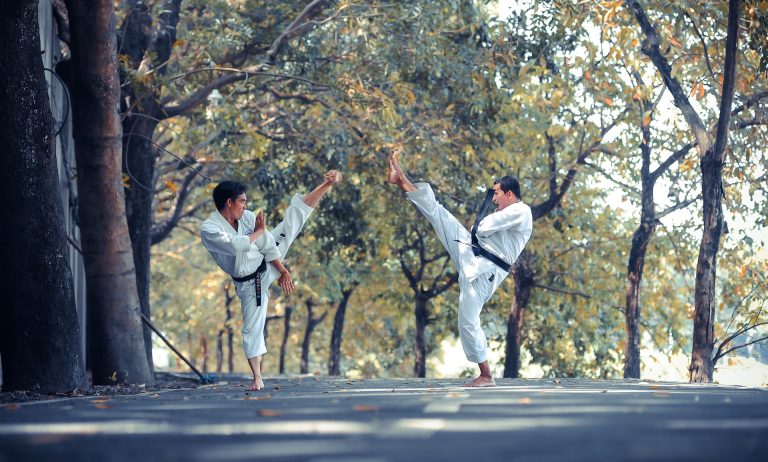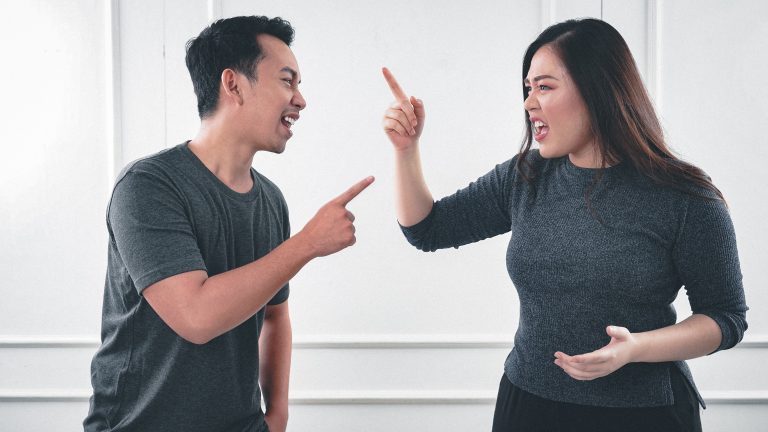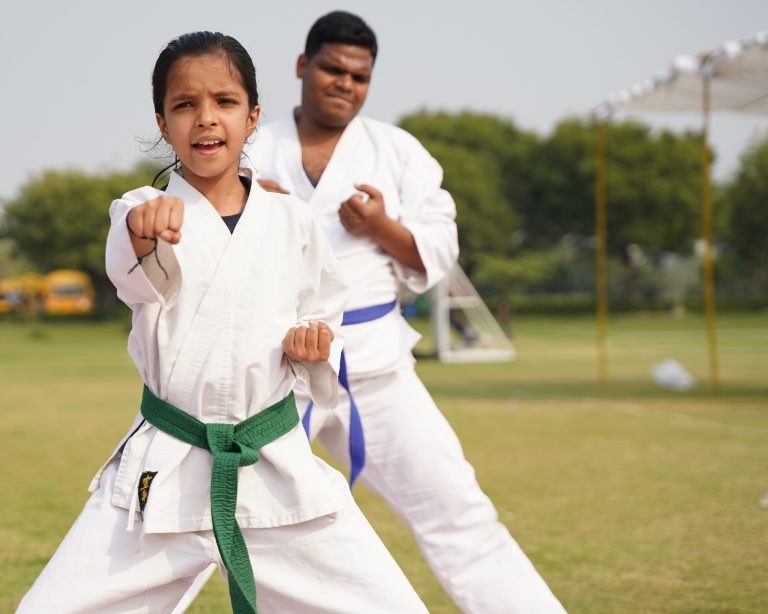Shotokan Karate Belt Colours: A Guide to Belt Ranking System
Karate is a martial art that originated from Okinawa, Japan, and it emphasizes self-defense, discipline, and physical fitness. It typically involves striking techniques, kicks, and blocks. The karate belt system is a way to distinguish students‘ skill level and experience in the art. The Shotokan karate belt colours have a specific order, which ranges from beginner to advanced levels.
In this article, we will explore the Shotokan karate belt ranking system, its colours, and what each belt represents.
The White Belt: A Blank Slate
The white belt is the first level in Shotokan karate, which represents a beginner student. The white belt shows that the student is new to the art and is essentially a blank slate without any knowledge or experience. The white belt also symbolizes purity or the lack of any negative qualities.
The Yellow Belt: A Sign of Progress
The yellow belt marks a student’s first promotion, and it signifies that the student has started making progress in the art. A student begins to learn the basic techniques of striking, blocks, and kicks. In addition, the student begins to learn the basics of katas, which are pre-arranged patterns that consist of a series of techniques.
The Orange Belt: A Symbol of Growth
The orange belt indicates that the student has made significant progress and has grown in their skill level. At this point, the student has learned more complex techniques and katas, in addition to refining the basics that they learned from the previous belt. The orange belt shows that the student has started to develop a deeper understanding of Shotokan karate.
The Green Belt: An Emblem of Knowledge
The green belt is a symbol of knowledge and understanding of the art. The student has internalized the basics of Shotokan karate and has become more advanced in their technique. The student has also demonstrated commitment to the art, regularly attending classes and training. The green belt also represents the cycle of growth and development in the art, as a green belt student continues to learn more about the art.
The Blue Belt: A Test of Resilience
The blue belt is considered a standard belt, but it signifies that the student has overcome challenges in their training. These challenges could include mastering more complex katas, techniques, or challenging sparring matches. The blue belt also reflects the student’s determination in continuing their training and improvement.
The Purple Belt: A Display of Confidence
The purple belt represents that the student has confidence in their skills in Shotokan karate. The purple belt student has gained a deep understanding of the art and has reached a notable level of proficiency in their skills. At this level, the student is expected to begin taking on additional leadership roles in the dojo.
The Brown Belt: A Sign of Maturity
The brown belt marks the student’s transition into the expert level of Shotokan karate. The student has demonstrated significant mastery of techniques, katas, and sparring. The brown belt also indicates maturity in the student’s approach to training, as well as a deep commitment to the art. The brown belt is a preparation for the final stretch of the journey towards the black belt.
The Black Belt: A Mastery of the Art
The black belt is the final level of the Shotokan karate belt ranking system. The black belt symbolizes mastery and perfection of the art. The student has reached the highest level of proficiency in technique, katas, and sparring. However, the black belt is not the end of the journey but, rather, the start of a new chapter of continuous learning and self-improvement.
Shotokan Karate Belt Colours
Most Frequently Asked Questions
Shotokan Karate is a traditional form of martial arts that has been practiced all around the world. The system is known for its rigorous training routine and discipline, and its use of a belt system. The belts are used to indicate the level of a student’s proficiency in the art. The Shotokan Karate belt colors follow a specific order, and each belt comes with its own set of requirements for advancement. In this blog post, we answer some of the most frequently asked questions about Shotokan Karate Belt Colors.
1. What are the Shotokan Karate Belt Colors?
Shotokan Karate uses a system of ten belts to denote a student’s level of proficiency in the art. The colors go in the following order:
– White Belt
– Yellow Belt
– Orange Belt
– Green Belt
– Blue Belt
– Purple Belt
– Brown Belt
– Red Belt
– Black Belt
– Gold Belt
2. What is the significance of each belt color?
Each belt color in Shotokan Karate has its own unique significance. The white belt represents a beginner, while the other colors represent progress and growth. Yellow represents the sun, while Green represents new growth. Blue symbolizes the sky, and Purple represents wisdom. Brown represents maturity and readiness for advancement. Red represents danger, and Black represents mastery. Finally, the Gold Belt is symbolic of spiritual attainment.
3. How long does it take to advance in the Shotokan Karate Belt System?
The time it takes to advance in the Shotokan Karate Belt System varies per individual. There is no set time frame for advancement, as it depends on the student’s dedication, skill level, and performance. Typically, it takes around two years to advance from White to Brown Belt. Advancement to higher belts takes longer, with some students taking up to five years to reach the Black Belt.
4. What are the requirements for advancing through the Shotokan Karate Belt System?
To advance through the Shotokan Karate Belt System, students must demonstrate proficiency in various techniques, such as katas, kihon, and kumite. Each belt has its own set of requirements, and students must master these requirements before being allowed to advance. Shotokan Karate also emphasizes the importance of a student’s attitude, behavior, and commitment to the art as part of the advancement process.
5. Can I skip a belt in the Shotokan Karate Belt System?
It is not possible to skip a belt in the Shotokan Karate Belt System. Each belt represents a specific level of knowledge and proficiency, and students must meet the requirements of each belt in order of progression before advancing to the next. However, some students may progress more quickly due to their natural skill and proficiency in the art.
6. Is there a difference in the Shotokan Karate Belt System between different countries?
While the Shotokan Karate Belt System is an internationally recognized system, there may be slight variations in the requirements for advancement between different countries. These variations typically reflect differences in style and training methodology between countries, but the general structure of the Belt System remains the same.
In conclusion, understanding the Shotokan Karate Belt Colors is an important part of training in this ancient martial art. By mastering the techniques and requirements of each belt, students can progress through the ranks and achieve a higher level of proficiency in the art. As with any martial art, the journey is long and challenging, but the rewards are well worth the effort.
Shotokan Karate Belt Colours: A Comprehensive Guide
Karate belts denote the rank and proficiency of the wearer. Shotokan Karate is a popular martial art that follows a structured grading system, with distinct levels represented by different coloured belts. In this post, we’ll look at the Shotokan Karate belt colours, their meanings, and the requirements for promotion from one belt to another.
The Shotokan Karate Belt Colours
The Shotokan Karate belt system follows a specific hierarchy, with students starting as white belts and progressing through a range of colours before reaching the coveted black belt. The following is a rundown of the colours in the Shotokan Karate belt system, along with their meanings:
White Belt
The white belt represents a beginner in Karate. It signifies the beginning of the journey towards knowledge and enlightenment.
Yellow Belt
The yellow belt represents the earth, from which a plant sprouts and takes root as the foundation for future growth. As a yellow-belt, students start to understand the fundamentals of Karate and begin to develop their technique.
Orange Belt
The orange belt signifies the growth and development of a plant as it starts to bear fruit. Students who wear the orange belt have achieved a level of confidence and proficiency in their technique that allows them to take on more advanced challenges.
Green Belt
The green belt represents the phase of growth and harmony. At this level, students have refined their technique and are developing an understanding of the interplay between their own movements and those of their opponent.
Blue Belt
The blue belt denotes the sky, reflecting the limitless potential of the student’s skill. Blue-belted students have honed their technique and are beginning to develop their own style, incorporating their own flair and creativity into their movements.
Purple Belt
The purple belt represents the transformation of the plant into a flower, signifying the student’s sophistication and creativity in their Karate practice. Students at this level are able to adapt their training and technique to suit different situations and opponents.
Brown Belt
The brown belt represents the ripening of the fruit and the fulfilment of the student’s potential. At this level, students have reached a high level of proficiency, and are able to perform complex techniques with ease and precision.
Black Belt
The black belt is the ultimate goal for many Karate practitioners. It signifies mastery of the art and is the culmination of years of hard work and dedication. Students who earn a black belt have demonstrated a deep understanding of the principles and techniques of Karate and are often viewed as teachers and mentors within the Karate community.
How to Earn a Higher Karate Belt
Earning a higher Karate belt requires a combination of skill, dedication, and hard work. In order to progress from one belt to the next, students must demonstrate their proficiency in a range of Karate techniques, as well as their understanding of the principles and philosophy underlying the martial art.
The specific requirements for earning each belt will vary between martial arts schools and organisations, but in general, the following guidelines apply to the Shotokan Karate belt system:
– White Belt to Yellow Belt: At this stage, students will typically focus on developing basic techniques and building a foundation of knowledge in the art of Karate. Basic punches, kicks, blocks, and stances are typically taught at this stage.
– Yellow Belt to Blue Belt: As students progress, they will be expected to build on their basic skills and develop more advanced techniques. Students may also start to learn basic self-defence principles and begin to explore the philosophy behind Karate.
– Blue Belt to Brown Belt: At this stage, students will be expected to demonstrate a high level of proficiency, both in their technique and their understanding of Karate principles. Sparring and free-style training may become more common at this stage, as students develop their ability to apply their knowledge and techniques in real-life situations.
– Brown Belt to Black Belt: The transition from brown to black belt is one of the most challenging and demanding stages in a student’s Karate journey. Students at this level are expected to be highly skilled and knowledgeable, demonstrating mastery of a range of advanced techniques. Students will often be required to complete a rigorous testing process in order to earn their black belt, which may include physical testing, written exams, and other assessments.
Conclusion
The Shotokan Karate belt system is a structured and well-defined system that allows students to gradually refine their technique and progress towards mastery of the martial art. By understanding the meaning behind each belt colour and the requirements for advancement, students can set realistic goals for their Karate journey and work towards achieving them. With dedication, perseverance, and a willingness to learn, anyone can achieve a higher rank in Shotokan Karate.
Inhaltsverzeichnis






